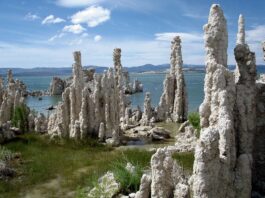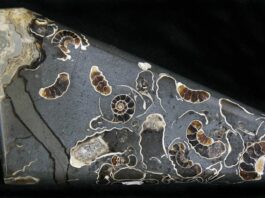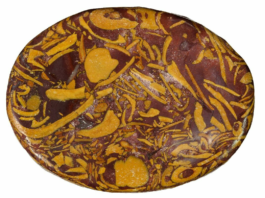Limestone is a sedimentary rock primarily composed of calcium carbonate (CaCO3) in the form of mineral calcite or aragonite. It is one of the most common and widely distributed rocks on Earth, with a wide range of uses in various industries and natural settings. Limestone forms through the accumulation and compaction of marine organisms, primarily the remains of shellfish and coral, over millions of years. This sedimentary rock can exhibit a wide array of textures and colors, depending on its composition, and it has been used by humans for countless purposes throughout history.


Texture: Clastic or Non-Clastic
Grain size: Variable, can consist of clasts of all sizes.
Hardness: Generally hard.
Major minerals: Calcite, dolomite
Composition: Limestone consists primarily of calcium carbonate, but it may also contain variable amounts of impurities such as clay, silt, and organic material. The presence of impurities can affect its color and texture.
Formation: Limestone forms in marine environments where the accumulation of calcium carbonate-rich organic debris, including shells and coral, is prevalent. Over time, these materials compress and harden, forming limestone deposits.
Types: There are various types of limestone, each with its unique characteristics. Some common varieties include chalk, marl, travertine, and tufa, which differ in terms of texture, origin, and usage.

Uses: Limestone is a versatile rock with a wide range of applications. It is commonly used as a building material in the construction industry for making concrete and mortar. It is also used in the production of lime, which is crucial for numerous industrial processes. Additionally, limestone is utilized in agriculture to improve soil quality and in the production of crushed stone for road construction and landscaping.
Appearance: Limestone can vary in appearance, with colors ranging from white and gray to yellow, brown, and even black, depending on the impurities it contains. It can have a variety of textures, from fine-grained to coarsely crystalline.
Fossils: Limestone often contains well-preserved fossils of marine organisms, making it valuable for scientific research and the study of Earth’s geological history.
Karst Landscapes: Limestone is known for its role in forming unique landscapes through chemical weathering processes, such as sinkholes, caves, and underground river systems, known as karst topography.
Historical Significance: Limestone has played a significant role in architecture and construction throughout history. Many famous buildings and landmarks, including the Great Pyramids of Giza and the Parthenon in Athens, were constructed using limestone.
Contents
- Properties and Uses of Limestone
- Occurrence and Distribution
- Chemical composition and properties of limestone
- Type of Limestone
- Classification of Limestone
- Folk Classification
- Dunham Classification
- Formation Process of Limestone
- Sedimentary structures and textures in limestone
- Geological Features
- Fossil content of limestone
- Limestone in agriculture and soil stabilization
- Common limestone formations around the world
- Interesting Facts and Trivia
- References
Properties and Uses of Limestone

Limestone is a versatile sedimentary rock with a wide range of properties and uses in various industries and applications. Its characteristics make it a valuable material for construction, agriculture, industry, and more. Here are the key properties and uses of limestone:
Properties of Limestone:
- Calcium Carbonate Content: Limestone is primarily composed of calcium carbonate (CaCO3), which gives it its fundamental chemical composition.
- Color: Limestone can vary in color, from white and gray to yellow, brown, and even black. The color often depends on impurities and mineral content.
- Texture: Limestone can have a variety of textures, ranging from fine-grained to coarsely crystalline. This texture impacts its suitability for different uses.
- Durability: Limestone is a durable and long-lasting material, making it suitable for many construction and architectural applications.
- Hardness: Limestone is relatively soft on the Mohs scale of mineral hardness (around 3), which means it can be easily carved and shaped for artistic and decorative purposes.
- Fossils: Many limestone deposits contain well-preserved fossils of marine organisms, making it valuable for scientific and paleontological research.
Uses of Limestone:
- Construction: Limestone is widely used as a building material for various construction purposes. It is used in the construction of buildings, bridges, walls, and monuments. Limestone is used for its aesthetic appeal and durability.
- Cement Production: Limestone is a key ingredient in the production of cement. It is ground into a fine powder and mixed with clay and other materials to create cement, which is essential in the construction industry.
- Agriculture: Limestone is used to improve soil quality and adjust its pH level. Agricultural limestone, also known as aglime, is added to soils to reduce acidity and provide essential nutrients to crops.
- Crushed Stone: Limestone is crushed into smaller pieces and used as a construction material for roads, sidewalks, and driveways. Crushed limestone is also used in landscaping and as a base material for construction projects.
- Industry: Limestone is utilized in various industrial processes. It is used to remove impurities in the production of metals, such as iron and steel. It is also employed in the production of glass, paper, and plastics.
- Water Treatment: Limestone is used in the water treatment industry to adjust the pH of water and to remove impurities and contaminants. It is a common material in the neutralization of acidic water.
- Art and Sculpture: Limestone’s relatively soft nature makes it an ideal material for sculptures, carvings, and architectural ornamentation. Many historic sculptures and architectural details were crafted from limestone.
- Fossil Collection and Research: Limestone’s fossil-rich nature makes it a valuable resource for paleontologists and collectors who study ancient marine life.
- Karst Landscapes and Caves: Limestone is integral to the formation of caves, sinkholes, and karst topography. These natural features have recreational and scientific significance.
Limestone’s wide range of properties and uses, from construction to agriculture and industry, has made it an invaluable resource for countless human endeavors and a significant contributor to the geological and cultural landscape.
Occurrence and Distribution

Limestone is a widespread sedimentary rock, and its occurrence and distribution can be found in various geological settings and regions around the world. Here are some key points regarding the occurrence and distribution of limestone:
- Marine Environments: Limestone predominantly forms in marine environments where the accumulation of calcium carbonate-rich materials takes place over extended periods. In such settings, the remains of marine organisms like shells, coral, and microorganisms contribute to the formation of limestone.
- Continental Shelves: Many limestone deposits are found on continental shelves, where shallow marine conditions favor the buildup of organic materials. These shallow-water environments are particularly conducive to the formation of calcareous sediments.
- Karst Landscapes: Karst landscapes are characterized by unique limestone terrain features, including sinkholes, caves, and underground river systems. These formations occur due to the dissolution of limestone by acidic groundwater. Famous karst regions include parts of Kentucky (USA), the Yucatan Peninsula (Mexico), and the Kras region (Slovenia).
- Cave Systems: Limestone caves are formed by the dissolution of limestone by groundwater. These caves can be extensive and are found in limestone-rich regions worldwide. Carlsbad Caverns in the United States and Mammoth Cave in Kentucky are well-known examples.
- Limestone Mountains: Some mountain ranges are primarily composed of limestone, and these often feature dramatic landscapes. For instance, the Italian Dolomites, part of the Alps, consist largely of dolomitic limestone. The Himalayan region also contains extensive limestone deposits.
- Desert Environments: In arid regions, the evaporation of water can lead to the precipitation of calcium carbonate, resulting in the formation of limestone deposits. This process can be observed in areas like the White Desert in Egypt.
- Islands and Coastal Regions: Many islands and coastal areas have limestone formations, often due to the uplift of ancient sea beds. The Florida Keys, for example, are made up of limestone and coral reefs.
- Underground Aquifers: Limestone aquifers store groundwater in fissures and cavities within the rock. These aquifers play a crucial role in providing a source of freshwater in regions with limestone geology.
- Global Distribution: Limestone deposits are found on every continent, and their distribution is influenced by local geological and environmental conditions. Notable limestone-rich areas include the United States (particularly in states like Florida and Kentucky), the United Kingdom, France, China, the Caribbean islands, India, and parts of the Middle East.
- Industrial Mining: Limestone is extensively quarried and mined for various purposes, including construction, cement production, and agriculture. Large limestone quarries can be found in many countries to meet the demand for building materials and industrial uses.
Limestone’s ubiquity and varied distribution make it an essential rock in both natural landscapes and human activities. Its geologic significance, aesthetic appeal, and practical utility in construction and industry have cemented its importance in our world.
Chemical composition and properties of limestone

Limestone is primarily composed of calcium carbonate (CaCO3) in the form of the mineral calcite. It may also contain other minerals such as dolomite (CaMg(CO3)2), clay minerals, and other impurities. The purity of limestone depends on the geological conditions under which it formed.
Limestone is a sedimentary rock that is typically white, gray, or tan in color, but it can also be found in various shades of blue, green, pink, or red. It is often composed of small fossils or shell fragments, indicating that it formed from the accumulation of calcium carbonate-rich marine organisms, such as coral, shellfish, and algae.
Limestone is a relatively soft rock with a Mohs hardness of 3, which means it can be easily scratched. It has a specific gravity of 2.7-2.9, which makes it less dense than most other rocks. It is typically soluble in acidic solutions, which is why limestone landscapes often feature caves, sinkholes, and other karst formations.
Type of Limestone
Limestone can be classified into different types based on both its composition and texture. These classifications help describe the various characteristics of limestone, making it easier to understand its suitability for different applications and its geological origins.
Classification based on composition:
- Calcitic Limestone: This type of limestone is primarily composed of calcium carbonate in the form of calcite. It is one of the most common types of limestone.
- Dolomitic Limestone: Dolomitic limestone contains a significant amount of calcium magnesium carbonate (CaMg(CO3)2) in addition to calcite. The presence of magnesium gives it its distinct characteristics. This type is known for its ability to neutralize acidity in soils and is used in agriculture for this purpose.
- Magnesian Limestone: Magnesian limestone contains high levels of magnesium carbonate (MgCO3). It is used in the production of magnesium metal and in various industrial applications.
- Marine Limestone: This type of limestone is formed from the remains of marine organisms like shells and coral. It is often rich in fossils and is commonly used in the construction of buildings and monuments.
- Chalk: Chalk is a fine-grained, soft, and porous variety of limestone, primarily composed of the microscopic remains of marine plankton. It is often white or light gray and is used for writing, drawing, and as a construction material.
- Oolitic Limestone: Oolitic limestone consists of small, spherical, or egg-shaped structures called ooids. It can be quite porous and is often used in architectural applications.
- Travertine: Travertine is a variety of limestone deposited by mineral springs, especially hot springs. It often has a banded or layered appearance and is known for its use in sculptures and building facades.
- Fossiliferous Limestone: This limestone type is rich in fossils, preserving the remains of ancient marine life. It is used for both scientific and decorative purposes.

Classification based on texture:
- Crystalline Limestone: Crystalline limestone has a well-developed crystalline structure, often with large calcite crystals. It can be visually striking and is used in decorative applications.
- Clayey Limestone: This type of limestone contains a significant amount of clay, resulting in a fine-grained texture. It is used in making cement and other industrial applications.
- Coquina: Coquina is a type of limestone made up of loosely cemented shell and coral fragments. It is relatively soft and is used in some construction and landscaping applications.
- Sandy Limestone: Sandy limestone contains a significant proportion of sand-sized particles. It is sometimes used as a construction material.
- Fossiliferous Limestone: As mentioned earlier, this type is rich in fossils and is more of a textural classification based on the presence of well-preserved fossils.
These classifications based on composition and texture help geologists, builders, and scientists understand the properties and uses of different types of limestone. Each type has its unique characteristics and can be suited to various applications, from construction to industrial processes and artistic endeavors.
Classification of Limestone

Two major classification schemes, the Folk and the Dunham, are used for identifying limestone and carbonate rocks.
Folk Classification
Robert L. Folk evolved a category gadget that places number one emphasis at the particular composition of grains and interstitial fabric in carbonate rocks. Based on composition, there are three most important additives: allochems (grains), matrix (often micrite), and cement (sparite). The Folk gadget uses -element names; the primary refers back to the grains and the second is the root. It is useful to have a petrographic microscope when using the Folk scheme, because it’s miles easier to determine the additives found in every pattern
Dunham Classification
The Dunham scheme specializes in depositional textures. Each call is based upon the feel of the grains that make up the limestone. Robert J. Dunham posted his system for limestone in 1962; it specializes in the depositional material of carbonate rocks. Dunham divides the rocks into 4 important corporations based on relative proportions of coarser clastic particles. Dunham names are essentially for rock families. His efforts cope with the question of whether or not or not the grains were at first in mutual contact, and therefore self-helping, or whether the rock is characterized by means of the presence of frame developers and algal mats. Unlike the Folk scheme, Dunham deals with the original porosity of the rock. The Dunham scheme is more beneficial for hand samples due to the fact it’s far primarily based on texture, now not the grains inside the sample
Formation Process of Limestone
Limestone is a sedimentary rock that forms through a complex process that involves the accumulation and compaction of calcium carbonate-rich materials over millions of years. The primary process of limestone formation can be summarized as follows:
- Accumulation of Calcium Carbonate: Limestone formation typically begins in marine environments where calcium carbonate (CaCO3) is abundant. This calcium carbonate comes from various sources, including the shells and skeletal remains of marine organisms like shells, coral, and microorganisms (such as foraminifera). These organisms extract calcium and carbonate ions from seawater to build their protective structures.
- Settling of Sediments: As these marine organisms die, their shells and skeletal fragments sink to the ocean floor. Over time, a layer of these calcium carbonate-rich sediments accumulates on the seabed.
- Compaction and Cementation: The weight of the overlying sediments exerts pressure on the accumulated calcium carbonate sediments. This pressure, along with the presence of minerals that act as natural cement, causes the sediments to harden and solidify. The calcium carbonate particles become tightly bound together.
- Chemical Changes: Chemical changes, such as the recrystallization of calcium carbonate, can occur over time. This process often results in the development of a crystalline structure within the limestone, making it a solid and durable rock.
- Diagenesis: Diagenesis refers to the physical and chemical changes that occur as sediments become sedimentary rocks. It involves the compaction of sediments, the expulsion of pore water, and the formation of minerals that cement the particles together.
- Lithification: The overall process of sediment compaction, cementation, and mineral alteration is known as lithification. Lithification is essential in transforming loose sediments into a coherent rock like limestone.
- Time and Pressure: The entire process of limestone formation takes millions of years. The sediments gradually build up, and the weight of the overlying materials increases the pressure on the sediments at the bottom. This pressure plays a crucial role in the hardening and solidification of the sediments.
- Post-Formation Changes: After formation, limestone rocks may undergo further changes due to geological processes, including folding, faulting, and metamorphism, which can alter their appearance and texture.
The specific characteristics of limestone, such as its texture, color, and composition, can vary depending on factors such as the types of marine organisms present, the environmental conditions in which it formed, and the presence of impurities.
It’s important to note that limestone formation is an ongoing process, and new layers of limestone are continually forming in modern marine environments. Over geological time scales, these accumulations of calcium carbonate sediments can become the limestone rocks that we see today, with rich fossil records and historical geological information.
Sedimentary structures and textures in limestone

Limestone is a sedimentary rock that often exhibits sedimentary structures and textures that can give clues to its depositional environment and history. Some of these features include:
- Fossils: Limestone often contains fossils of marine organisms, such as shells, corals, and crinoids, that are preserved in the rock.
- Bedding: Limestone often has well-defined layers, or bedding, that can be horizontal or inclined.
- Ripple marks: These are small ridges on the surface of the limestone that form as a result of wave or current action in shallow marine environments.
- Mud cracks: These are polygonal cracks that form as mud dries out and shrinks, indicating that the limestone was deposited in an environment that alternated between wet and dry conditions.
- Oolites: These are small, rounded grains of calcium carbonate that are often found in limestone, indicating that the rock formed in a shallow marine environment with high carbonate precipitation rates.
- Grain size: Limestone can range from fine-grained to coarse-grained, depending on the depositional environment and the size of the original sediment particles.
- Color and texture: Limestone can vary in color from white to gray to brown, and can have a crystalline, clastic, or microcrystalline texture.
The sedimentary structures and textures found in limestone can provide important information about the environment in which the rock formed, and can aid in the interpretation of the geologic history of a region.
Geological Features
Limestone is associated with several distinctive geological features and landscapes, including caves and karst topography, as well as significant paleontological features like fossils. Here’s an overview of these geological aspects:

- Caves and Karst Landscapes:
- Caves: Limestone is closely linked to the formation of caves, which are natural underground voids or passages. These caves are created through a process of chemical weathering known as karstification. Rainwater, which is slightly acidic due to the absorption of carbon dioxide from the atmosphere, seeps into the limestone. This mildly acidic water dissolves the calcium carbonate in the limestone, creating cavities and passages over time. Famous limestone cave systems include Mammoth Cave in Kentucky, USA, and Carlsbad Caverns in New Mexico, USA.
- Karst Landscapes: Karst topography refers to landscapes characterized by distinctive features resulting from the dissolution of limestone or other soluble rocks. These features can include sinkholes, disappearing streams, underground rivers, and extensive cave networks. Karst landscapes are often marked by rugged terrains and unusual geological formations. Well-known karst regions include parts of Kentucky, the Yucatan Peninsula in Mexico, and the Kras region in Slovenia.
- Fossils and Paleontological Significance:
- Preservation of Marine Life: Limestone is often rich in fossils due to its formation in marine environments. The remains of marine organisms, such as shells, coral, and microorganisms, are preserved within the rock. These fossils provide valuable insights into Earth’s geological history and the evolution of marine life.
- Index Fossils: Some limestone formations are especially significant for paleontologists because they contain specific types of fossils known as “index fossils.” These fossils are used to date geological layers and correlate rock formations across different regions, aiding in the understanding of the Earth’s history.
- Scientific Research: Limestone’s fossil-rich nature has made it a critical resource for scientific research, enabling the study of ancient ecosystems and contributing to our understanding of past climates, biodiversity, and evolutionary processes.
- Karst Topography:
- Dissolution Features: Karst topography is characterized by various surface and subsurface features created by the dissolution of limestone. Sinkholes are common depressions in the landscape where the surface has collapsed into underground cavities. These features are often found in karst regions.
- Underground Rivers and Springs: In karst areas, underground rivers and springs may form as rainwater percolates through the limestone, creating extensive networks of subterranean watercourses. These underground systems can be interconnected, leading to the emergence of clear, fast-flowing springs.
- Limestone Pavements: Limestone pavements are flat expanses of exposed rock, often marked by intricate patterns of cracks and grooves. They form as a result of the chemical weathering of limestone and are a distinctive feature of karst landscapes.
The geological features associated with limestone, particularly caves, karst landscapes, and fossils, have not only scientific importance but also significant cultural and recreational value. They attract researchers, explorers, and tourists alike, offering opportunities for scientific study, adventure, and a deeper understanding of Earth’s history and the natural world.
Fossil content of limestone

Limestone can contain various types of fossils, ranging from microfossils to macrofossils, depending on the depositional environment and age of the rock. Microfossils found in limestone can include foraminifera, coccoliths, and diatoms, while macrofossils can include shells of marine invertebrates such as mollusks, bryozoans, and corals. Fossils in limestone can provide important information about the depositional environment and the age of the rock, as well as give clues about the past climate, geography, and evolution of life on Earth.
Limestone in agriculture and soil stabilization
Limestone has a variety of agricultural and soil stabilization uses due to its chemical composition and physical properties. When applied to soil, limestone can neutralize soil acidity and supply plants with essential nutrients.
Limestone is a source of calcium and magnesium, which are necessary nutrients for plant growth. The calcium in limestone helps to neutralize soil acidity, which can be harmful to plants. The magnesium in limestone is also important for plant growth, as it is an essential component of chlorophyll, the pigment that gives plants their green color and helps them convert sunlight into energy through photosynthesis.
In addition to its nutrient content, limestone can also improve soil structure and drainage. When added to heavy clay soils, limestone can help to break up the soil particles, allowing for better water and air movement through the soil. This can improve soil drainage and reduce the risk of waterlogging, which can be harmful to plants.
Limestone can also be used for soil stabilization in construction projects. It is often mixed with soil to create a stable base for roads, buildings, and other structures. Limestone can improve the stability of the soil by reducing its plasticity, increasing its shear strength, and reducing the amount of settlement that occurs over time.
Common limestone formations around the world
Limestone formations are found all over the world, and they exhibit a variety of geological and geographical features. Here are some common limestone formations from different regions around the world:
- Karst Landscapes (Various Locations): Karst topography is a widespread limestone formation characterized by unique features such as sinkholes, caves, underground rivers, and limestone pavements. Prominent karst regions include:
- Mammoth Cave, Kentucky, USA: Mammoth Cave is the world’s longest known cave system and is located in a karst region in Kentucky.
- Yucatan Peninsula, Mexico: The Yucatan Peninsula is known for its extensive cenotes (sinkholes), cave systems, and underground rivers, all formed in limestone.
- Kras Plateau, Slovenia: The Kras region in Slovenia features numerous karst formations, including deep sinkholes and limestone pavements.
- White Cliffs of Dover, England: The White Cliffs of Dover are iconic chalk cliffs formed from the remains of microscopic marine organisms over millions of years. Chalk is a soft, fine-grained variety of limestone.
- The Burren, Ireland: The Burren in County Clare, Ireland, is a unique karst landscape characterized by limestone pavements with deep fissures. It is home to various rare and endemic plant species.
- Cappadocia, Turkey: Cappadocia is known for its surreal landscapes, including cone-shaped rock formations and cave dwellings, all created from the erosion of soft, volcanic limestone.
- Limestone Pinnacles of Ha Long Bay, Vietnam: Ha Long Bay is famous for its thousands of towering limestone pinnacles and islets that have formed over millions of years.
- Phang Nga Bay, Thailand: This bay is known for its dramatic limestone karst formations that rise dramatically from the water. It is a popular destination for sea kayaking and exploration.
- Guilin and Yangshuo, China: The karst formations in Guilin and Yangshuo are characterized by limestone peaks, caves, and a picturesque river landscape.
- Bungle Bungle Range, Australia: Located in the Purnululu National Park in Western Australia, the Bungle Bungle Range features striking cone-shaped limestone formations.
- Waitomo Caves, New Zealand: The Waitomo Caves are renowned for their unique limestone formations and glowworm species that illuminate the caves.
- Dolomite Alps, Italy: The Dolomite Alps in northern Italy are known for their towering limestone peaks with distinct, jagged silhouettes.
These are just a few examples of limestone formations found around the world. Limestone’s ability to create diverse and captivating landscapes, as well as its role in geological processes, has made it a subject of scientific study and a source of natural beauty and wonder.
Interesting Facts and Trivia
Limestone is a remarkable rock with a fascinating geological history, and it has left its mark on the Earth’s landscape in many notable ways. Here are some interesting facts, trivia, and famous limestone landmarks:
Interesting Facts and Trivia:
- Building Blocks of History: Limestone has been used in the construction of many famous historical landmarks, including the Great Pyramids of Giza, the Parthenon in Athens, and the Colosseum in Rome.
- Sculpting and Art: The softness of some limestone varieties, like chalk, makes it a preferred medium for sculptors and artists. The famous statue of David by Michelangelo was sculpted from Carrara marble, a type of limestone.
- Limestone Caves: Limestone caves are known for their impressive formations, including stalactites and stalagmites. Carlsbad Caverns in New Mexico, USA, has one of the largest underground chambers in the world.
- Index Fossils: Limestone deposits often contain index fossils, which are used by geologists to date rock layers and correlate geological formations across different regions.
- Agricultural Lime: Limestone is commonly used in agriculture to improve soil pH and provide essential nutrients to crops. It is known as agricultural lime or aglime.
- Versatile Industrial Uses: Limestone is used in various industrial applications, including the production of cement, glass, and paper. It is also used in the purification of metals like iron and steel.
Famous Limestone Landmarks:
- White Cliffs of Dover, England: These iconic chalk cliffs are not only a symbol of England but also a vital part of its history, serving as natural fortifications in times of war.
- The Cliffs of Moher, Ireland: These dramatic sea cliffs are made of limestone and offer breathtaking views of the Atlantic Ocean.
- Bungle Bungle Range, Australia: Located in the Purnululu National Park, the Bungle Bungle Range features distinctive cone-shaped limestone formations.
- Ha Long Bay, Vietnam: This UNESCO World Heritage Site is known for its thousands of towering limestone pinnacles and islands.
- Trolltunga, Norway: This unique rock formation, often called the “Troll’s Tongue,” juts out horizontally from a mountain and is a popular spot for hikers and adventurers.
- Giant’s Causeway, Northern Ireland: A natural wonder, this area is known for its hexagonal basalt columns, but it also features limestone formations along the coast.
Unique Geological Features:
- Karst Topography: Limestone is closely associated with karst landscapes, characterized by sinkholes, caves, and underground rivers formed through the dissolution of the rock by slightly acidic water.
- Limestone Pavements: Limestone pavements are flat expanses of exposed rock with intricate patterns of cracks and grooves, often found in karst regions.
- Sinkholes: Sinkholes are depressions in the landscape caused by the collapse of surface materials into underground limestone cavities.
- Karst Springs: Springs in karst regions can have a remarkable clarity due to the filtering action of the limestone, making them popular for drinking water sources.
Limestone’s role in shaping the Earth’s surface and its use in architecture, art, and industry have left an indelible mark on our world and have made it an object of fascination for scientists, artists, and explorers alike.
References
- Bonewitz, R. (2012). Rocks and minerals. 2nd ed. London: DK Publishing.






